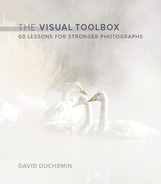Lesson 15. Use Tighter Apertures to Deepen Focus
I’m not sure how it happened that we became so obsessed with wide apertures and thin-as-a-leaf planes of focus, but there is something we seem to like about shallow depth of field. Perhaps it’s the way it simplifies the image and softens the details into color and shape, allowing us to subtly guide the eye of the reader where we want it to go. But while dreamy bokeh (a Japanese word used to describe what, without this word, I’d just call the blurry-out-of-focus bits) gets all the glory, it’s not the only tool in the box. I spent years shooting wide open, happy as can be with my shallow depth of field, until I began making photographs with greater depth, and I wanted my photographs to have sharpness beyond the first few feet of foreground.
Nikon D800, 23mm, 1/400 @ f/11, ISO 200
A scene from Deception Island in Antarctica. With this wide lens at f/11, it’s sharp from front to back.
“While dreamy bokeh gets all the glory, it’s not the only tool in the box.”
Photographs are about light, lines, and moments. What those lines look like, and the kind of information or impact they are allowed to carry in an image, will depend, in part, on how focused they are. And what is in or out of focus can significantly change how the story is told. A bride, for instance, may look stunning in her gown, the background allowed to fall off into fuzzy oblivion, but if the groom is in that background, blurring him doesn’t just render him a soft, tuxedoed man, but a detail about which you are saying, “The particular identity of this man doesn’t really matter.” You might not need him perfectly sharp, but don’t get so seduced by the look of shallow depth of field that you let your storytelling skills go dull.
First, the same things you needed to know about wider apertures are things you still need to know about tighter ones, so if you skipped Lesson 14, head back there and read up. But now we’re talking about tighter apertures and deeper depth of field, so here are a few things you need to know specifically about this:
• If you’re going for maximum sharpness, the initial temptation is to crank the aperture as tight as it’ll go. Dial it down to f/22 and leave it there. But although this seems right in theory, in practice lenses get a little softer at the tightest apertures, so you’re not likely to gain much in going too tight. I usually stop around f/16 these days, focus a third into my scene (remember the 1/3-in-front,-2/3-in-back rule about depth of focus?), and leave it there.
• The tighter your aperture, the deeper the focus. This extends even to things like dust on your sensor. If you’ve got dust there—and most of us do—then you might not have noticed it while making photographs at f/1.2. You’re going to notice it now if you’re at f/16. Don’t panic. Get the sensor cleaned and be a little more diligent about keeping it clean.
• A tighter aperture has another curious effect, one I use often. At around f/16 small pinpoints of light become starbursts. You may not specifically need your plane of focus to be that deep, but choosing the tighter aperture is the only way to render this effect without digging through bins of used filters from the 1980s.

